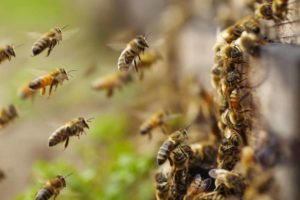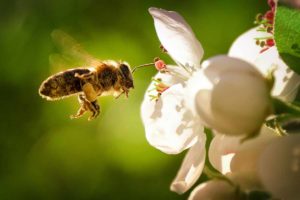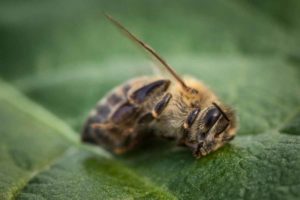Declining Bee Population:
Why Humane Removal is Critical
14 min read Updated for March, 2019
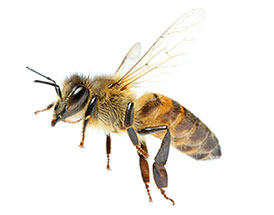 Bees may seem like a nuisance due to their painful stings, but they also play a vital role in fertilizing the crops that become food on our table.
Bees may seem like a nuisance due to their painful stings, but they also play a vital role in fertilizing the crops that become food on our table.
Unfortunately, the bees that we rely on for pollinating plants are losing numbers quickly because of a wide range of factors from pesticide use to loss of habitat. For this reason, it’s more important than ever to treat bees humanely when we encounter them on our property.
Bee Problem?
TABLE OF CONTENTS
Bee Sounds
The buzzing sound associated with bees is due to their wings and are actually a vibration. The buzzing may increase if they are aggravated or threatened, thus the wings moving more rapidly or aggressively, but generally bees are happy to be busy buzzing flowers. Honey bees are also known for emitting a ‘piping’ sound, a particular type of high pitched buzzing.
Bee Poop
If you live close to a bee hive, or close to its food source, you may have noticed a build up of sticky, yellow clumps. And since bees keep their hives immaculate, business is done back and forth from the food source. Keep an eye out for the increase of sticky, yellow clumps (on the ground, on a tree, on your car), specifically from spring to summer when bee numbers are at their highest. The dropping are hard to remove, but if on a building, car, or clothing you can try a lengthy soaking before a thorough washing.
Why Are Bees So Important?
Even though bees aren’t the only insect that pollinates crops, they’re one of the most significant contributors to the process. Scientists estimate that we depend on bee pollination for up to one-third of the food we eat, including 100 key crops like nuts, fruit, and beans. The loss of bees doesn’t just aect our stomachs, but our GDP. According to National Geographic, bees contribute $15 billion to U.S. crop production.
Domestic Bees vs. Wild Bees
Domestic Bees
Are the bees you encounter in your garden the same ones that pollinate these essential crops? Yes and no. While wild bees always help in the process, many crops rely on domestic populations of bees to pollinate their plants at certain times of the year. These bees-for-hire are cultivated by professional beekeepers who transport their bee colonies to different areas of the country depending on their pollination needs in each season.
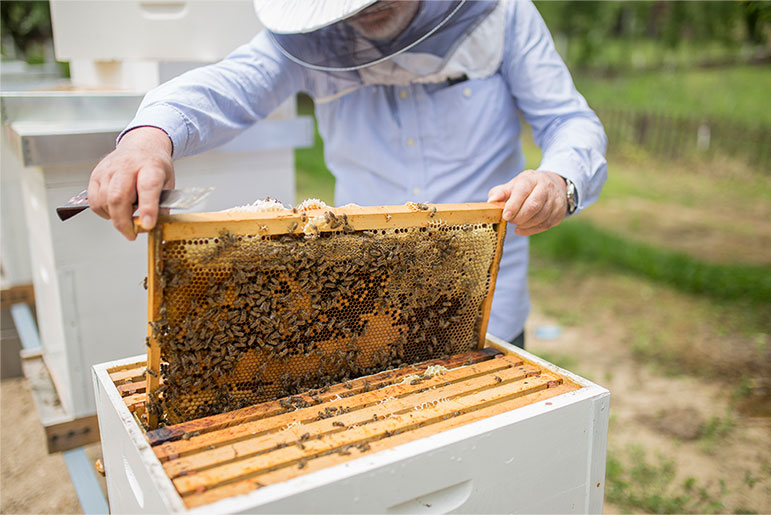
For example, almond orchards across California require roughly 1.6 million domestic bee colonies to properly pollinate their crops each year, according to an article from Yale Environment. Farmers say it’s getting harder and harder to find this many bees.
Wild Bees
Though they don’t play as much of a commercial role, wild bees can be important players in plant production as well. Studies have shown that having a robust population of wild bees can help dramatically increase crop growth. Scientists point to their more efficient method of pollination for this uptick in crop yields. Of course, pollinating commercial crops isn’t the only purpose bees serve.
These tiny insects are also responsible for supporting healthy ecosystems by pollinating wild trees, flowers, and other plants that are vital for clean air and feeding wildlife. So far, scientists seem less concerned about the health of wild bees, but say that their numbers are being affected more and more. While some species of wild bees seem to be holding at normal levels, other species are all but disappearing from the landscape.
TABLE OF CONTENTS
Many crops rely on domestic populations of bees to pollinate their plants at certain times of
article continues below
Why Are Bees Dying?
Scientists estimate that we depend on bee pollination for up to one-third of the food we eat.
Even though bees aren’t the only insect that pollinates crops, they’re one of the most significant contributors to the process. Scientists estimate that we depend on bee pollination for up to one-third of the food we eat, including 100 key crops like nuts, fruit, and beans. The loss of bees doesn’t just affect our stomachs, but our GDP. According to National Geographic, bees contribute $15 billion to U.S. crop production.
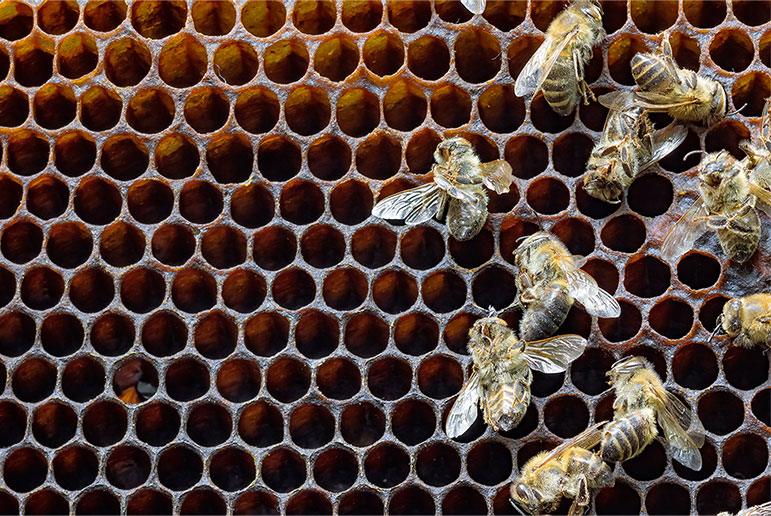
While pesticide poisoning and disease are also common culprits of colony death, CCD is unique in that its causes are largely mysterious.
Colony Collapse Disorder (CCD)
CCD is the phenomenon of worker bees leaving seemingly healthy hives and never returning. When they leave behind the hive—and the food, shelter, and remaining queen and nurse bees inside—the hive collapses. The other bees cannot survive without the worker bees foraging for food. While pesticide poisoning and disease are also common culprits of colony death, CCD is unique in that its causes are largely mysterious. Both pesticide poisoning and disease result in a pile of dead bees very near the hive itself, leaving little doubt as to what killed them, according to the EPA. However, in CCD the worker bees scatter and never return. Researchers are left wondering what caused their departure, but they speculate that several factors could be at play. These include newly evolved diseases, habitat loss, stress, and compromised immune function due to a combination of these issues.
Pesticide Poisoning
Pesticides have been a widely recognized factor in bee population decline for decades, but scientists are still working out the details of which pesticides kill bees at what levels. One known bee-damaging pesticide is neonicotinoids. For the most part, scientists had assumed that bees died when directly exposed to large amounts of this chemical during the growing season. However, a study referenced at PBS.org proves otherwise. These neonicotinoids affect bees year-round and are absorbable from many different sources, not just the crop they were put on.
Scientists say the pesticides dissolve from the crops they’re initially administered to and leak into the water supply, spreading to nearby plants. These trees and flowers soak up the contaminated water and produce pesticide-laced pollen that bees then pick up. Unfortunately, these results mean that neonicotinoids are harder to regulate than previously thought and may be having a cumulative eect on bees. These chemicals are particularly damaging for queen bees, compromising a colony’s ability to reproduce.
Humane Bee Removal
Based on this information, it’s easy to see why conserving our natural bee population is so essential to the flourishing of our food supply. If you encounter a hive of bees on your property, it’s necessary to know the proper steps to keep both yourself and the bee colony safe. Here are a few bee situations you may face and what to do if they occur near you.
If you see a sizable cluster of bees together out in the open, it’s likely that they’re in the process of scouting out a new home.
Swarming Bees
Swarming occurs when a colony of bees has outgrown their current hive. The queen and roughly half of the worker bees will leave the hive to seek out a new location. If you see a sizable cluster of bees together out in the open, it’s likely that they’re in the process of scouting out a new home. The good news is that these bees are highly focused on their taste of relocating and unlikely to sting. They’re also easier for professionals to catch while swarming, which can help ensure that they don’t decide to build a hive too close to your home. Always call a local beekeeper or bee relocation service if you see a swarm near your house. Never attempt to catch or redirect the bee swarm yourself.
Bees Near the Exterior of Your Home
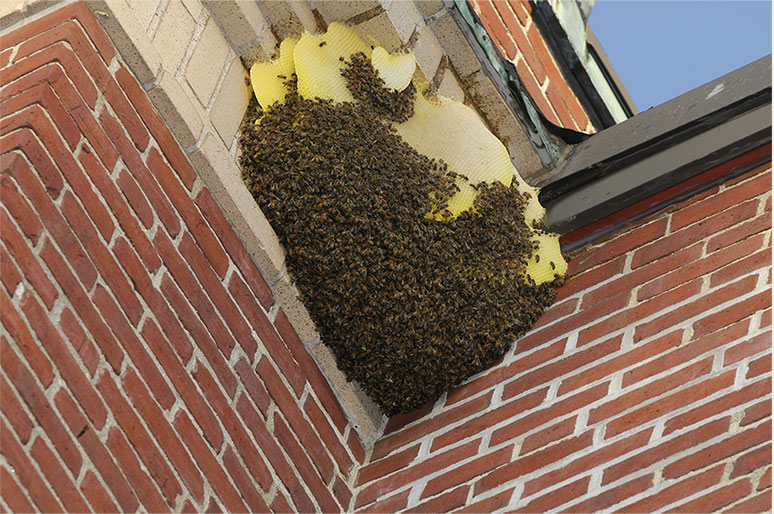
If you encounter a large hive of bees near your house—at an entrance for example—there’s more leeway in deciding how to handle the situation. Most bees are not aggressive and are unlikely to pose much of a threat unless provoked. Since bee nests only last a season, you may want to consider leaving the hive and just trying to avoid the area until the bees have moved on. If you have young children or a family member who’s allergic to bee stings, however, it may be worth calling a professional to relocate the hive.
